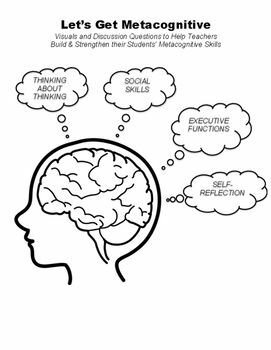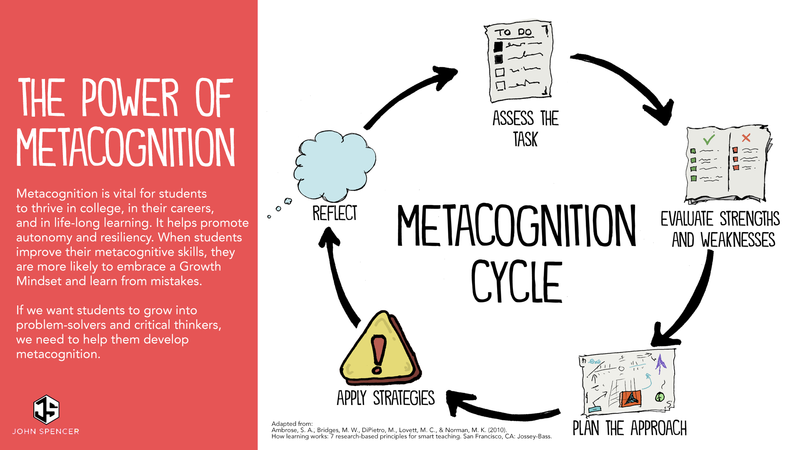e-Learning Ecologies MOOC’s Updates
Critical analysis
Metacognition or “thinking about thinking” addresses knowledge and its regulation (Fig. 1). Metacognition can be defined as “thinking that exemplifies disciplinary practice—to think like a historian, writer or physicist” [Cope and Kalantzis, 2017]. It consists of metamemory, motivation, problem solving and critical thinking. Our course facilitator, Mary Kalantzis, points out in ‘Metacognition, Part 6A’ that metacognition is important to prepare one for real world. Martinez defines Critical thinking as “evaluating ideas for their quality, especially judging whether or not they make sense,” [2006]. Critical analysis covers the analysis of any argument/ project, draw inference, and evaluate the strategies. It is also about disposition such as habits and attitudes.
Fig. 1. Metacognitive skills. Accessed from https://in.pinterest.com/pin/505388389418369574/
Though crucial for higher order thinking skills development, critical analysis cannot be easily taught. It is important to understand its different facets [Spencer, 2018]. I think, when students work on a given project, they get exposed to different aspects like ability to plan, comprehend, perform the task, monitor, and evaluate the strategies/ tasks [Lai, 2011]. They gain tremendous knowledge in the whole process and evolve as a person. It really transforms them and teaches them to be a critical evaluator. The various aspects for development of critical analysis are discussed (Fig. 2).
Formulate a problem/ Assess the task: When a project is assigned or chosen by students, they must integrate the prior knowledge and understand the project. It is important, because as a teacher, I talk to students and based on their interests, suggest topic(s) for a project.
Evaluate their knowledge/ skills: The trick here is that the students should not under or over-estimate their potential. Again, as a mentor, guide, nudge or encourage the students. The students should be able to search and gather the relevant data related to the project. There is no single recipe for all to comprehend the given task.
Plan their approach: It requires regular monitoring. I prefer that the initial draft of work plan is entirely made by the students and then raise questions/ discuss and help them to think and rethink about their plan. It is important to deliberate upon the plan.
Monitor their progress: Assess, re-assess and devising new strategies are all part of regular monitoring. Teacher role is critical in giving the direction and help students learn how to assess or evaluate themselves. It is an important life-skill which nurtures them for future.
The whole process is assisted by feedback, reflection, and assessment at different levels by both students and mentor.
Fig. 2. The steps in critical analysis. Accessed from: http://www.spencerauthor.com/metacognition/
Metacognition cycle can be watched and understood at this link (https://youtu.be/HZrUWvfU6VU)
As a teacher and researcher, I work on different projects with students. The project plan, execution, publication need constant critical evaluation. The ease of search and availability of scientific papers at a click has made the life simple as compared to the previous grind of Index Medicus cards and searching the relevant data through diskette.
A.J. Juliani emphasizes it well, “Our job as teachers is not to ‘prepare’ kids for something; our job is to help kids learn to prepare themselves for anything.” Critical evaluation integrates skills and knowledge to plan and execute the given goal. The different stages in critical thinking as described by Lynch et al. [2002] are “confused fact finders”, “biased jumpers”, “perpetual analyzer”, “pragmatic performer” and “strategic revisioner”. Teachers at school and college can play an especially important role in modulating the student through these stages. It is a higher-order cognitive skill which needs to be developed so that young mind is ready to face the real world.
References
Cope, B., and Kalantzis, M. (2017). Conceptualizing e-learning. In B. Cope and M. Kalantzis (Eds), e-Learning Ecologies. New York: Routledge.
Lai., E.R. (2011). Metacognition: A Literature Review. A Research report. https://images.pearsonassessments.com/images/tmrs/Metacognition_Literature_Review_Final.pdf
Lynch, C. L., Wolcott, S. K., & Huber, G. E. (2002). Steps for better thinking: A developmental problem solving process.
Martinez, M. E. (2006). What is metacognition? Phi Delta Kappan, 696-699.
Spencer, J. (2018). Five ways to boost metacognition in the classroom. Accessed on Aug. 6. 2020. http://www.spencerauthor.com/metacognition/




Nicely done. I especially liked how you included facilitating strategies throughout the project.